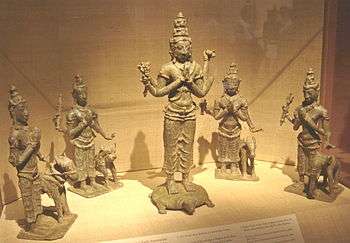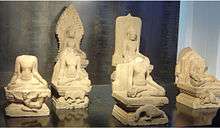Guardians of the directions
The Guardians of the Directions (Sanskrit: दिक्पाल, Dikpāla) are the deities who rule the specific directions of space according to Hinduism and Vajrayāna Buddhism—especially {{IAST|Kālacakra}}. As a group of eight deities, they are called Aṣṭa-Dikpāla (अष्ट-दिक्पाल), literally meaning guardians of eight directions. They are often augmented with two extra deities for the ten directions (the two extra directions being zenith and nadir), when they are known as the Daśa-dikpāla. In Hinduism it is traditional to represent their images on the walls and ceilings of Hindu temples. Ancient Java and Bali Hinduism recognize Nava-Dikpāla, literally meaning guardians of nine directions, that consist of eight directions with one addition in the center. The nine guardian gods of directions is called Dewata Nawa Sanga (Nine guardian devata), the diagram of these guardian gods of directions is featured in Surya Majapahit, the emblem of Majapahit empire.
There are strong similarities between the concept of the guardians of the directions and the lore surrounding the Chinese four symbols, four ancestral spirits who are responsible for four of the cardinal directions (North, South, East, and West).
Names and attributes
The names of the Dikpālas vary slightly, but generally include the following:
| Name | Direction | Mantra | Weapon | Consort | Graha (Planet) | Guardian Mātṛkā |
|---|---|---|---|---|---|---|
| Kubera | North | Oṃ Śaṃ Kuberāya Namaḥ | Gadā (mace) | Kuberajāyā | Budha (Mercury) | Kumārī |
| Yama | South | Oṃ Maṃ Yamāya Namaḥ | Daṇḍa (staff) | Yami | Maṅgala (Mars) | Varahi |
| Indra | East | Oṃ Laṃ Indrāya Namaḥ | Vajra (thunderbolt) | Śacī | Surya(sun) | Aindri |
| Varuṇa | West | Oṃ Vaṃ Varuṇāya Namaḥ | Pāśa (noose) | Nalani | Śani (Saturn) | Varuṇī |
| Īśāna | Northeast | Oṃ Haṃ Īśānāya Namaḥ | Triśūla (trident) | Pārvatī | Brahspati (Jupiter) | Māheśvarī |
| Agni | Southeast | Oṃ Raṃ Agnaye Namaḥ | Śakti (Spear) | Svāhā | Śukra (Venus) | Meṣavāhinī |
| Vāyu | Northwest | Oṃ Yaṃ Vāyuve Namaḥ | Aṅkuśa (goad) | Bhāratī | Candra (Moon) | Mṛgavāhinī |
| Nirṛti (sometimes Rakṣasa) | Southwest | Oṃ Kṣaṃ Rakṣasāya Namaḥ | Khaḍga (sword) | Khaḍgī | Rāhu (North Lunar Node) | Khaḍgadhāriṇī |
| Brahmā | Zenith | Oṃ Hriṃ Brahmaṇe Namaḥ | Padma (lotus) | Sarasvatī | Ketu (South Lunar Node) | Brahmāni |
| Viṣṇu | Nadir | Oṃ Kliṃ Viṣṇave Namaḥ | Chakra (discus) | Lakṣmī | Lagna | Vaiṣṇavī |
Directions in Hindu tradition
Directions in Hindu tradition are called as Diśā, or Dik. There are four primary directions and a total of 10 directions.
| English | Sanskrit |
|---|---|
| East | Pūrva, Prācī, Prāk |
| West | Paścima, Pratīcī, Aparā |
| North | Uttara, Udīcī |
| South | Dakṣīṇa, Avāchip |
| North-East | Īśānya |
| South-East | Āgneya |
| North-West | Vāyavya |
| South-West | Nairṛtya |
| Zenith | Ūrdhvā |
| Nadir | AdhaH |
Lokapālas

In Hinduism the Guardians of the eight cardinal directions are called the Lokapālas (लोकपाल) or Ashta Dikpalakas. They are:
- Indra (east)
- Agni (south - east)
- Yama (south)
- Nirṛti ( South - west)
- Varuṇa (west)
- Vayu (North west)
- Kubera (north)
- Īśāna (north east)[1]
References
- ↑ Gopal, Madan (1990). K.S. Gautam, ed. India through the ages. Publication Division, Ministry of Information and Broadcasting, Government of India. p. 71.
- Dictionary of Hindu Lore and Legend (ISBN 0-500-51088-1) by Anna Dallapiccola
- The Gods of the Directions in Ancient India. Origin and Early Development in Art and Literature (until c. 1000 A.D.), Berlin: Dietrich Reimer 2001 (ISBN 3-496-02713-4) by Corinna Wessels-Mevissen
See also
| Wikimedia Commons has media related to Lokapala. |

